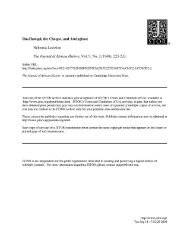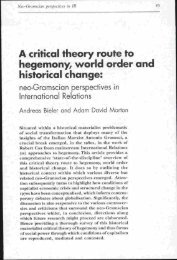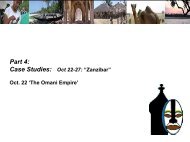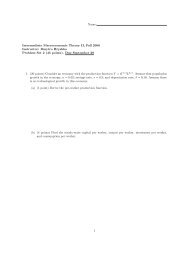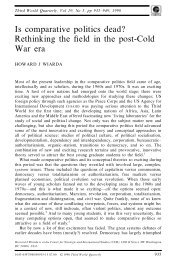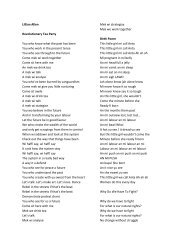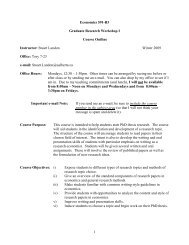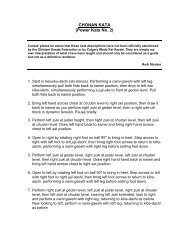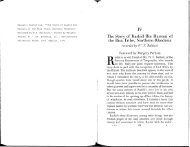2 Ethnocentric Projection and the Study of Kinship
2 Ethnocentric Projection and the Study of Kinship
2 Ethnocentric Projection and the Study of Kinship
You also want an ePaper? Increase the reach of your titles
YUMPU automatically turns print PDFs into web optimized ePapers that Google loves.
<strong>Ethnocentric</strong> <strong>Projection</strong> <strong>and</strong> <strong>the</strong> <strong>Study</strong> <strong>of</strong> <strong>Kinship</strong> … May 2008 8<br />
attached to <strong>the</strong>m. Indeed, <strong>the</strong> social <strong>and</strong> cultural attributes, though considered <strong>the</strong><br />
primary subject matter <strong>of</strong> anthropologists, <strong>and</strong> <strong>of</strong> particular concern to social<br />
scientists, are never<strong>the</strong>less derivative <strong>of</strong> <strong>and</strong> <strong>of</strong> less determinate significance than <strong>the</strong><br />
biological relations. These biological relations have special qualities; <strong>the</strong>y create <strong>and</strong><br />
constitute bonds, ties, solidary [sic] relationships proportional to <strong>the</strong> biological<br />
closeness <strong>of</strong> <strong>the</strong> kind … These are considered to be natural ties inherent in <strong>the</strong><br />
human condition, distinct from <strong>the</strong> social or cultural. (p.188).<br />
Although Schneider here refers back to <strong>the</strong> naturalness or perhaps innateness <strong>of</strong> kinship<br />
relations with his characterization <strong>of</strong> <strong>the</strong>m as “natural ties inherent in <strong>the</strong> human condition”,<br />
<strong>the</strong> primary pair <strong>of</strong> characterizations in this passage is <strong>of</strong> biological relations as being<br />
important or having significance in abstraction from any o<strong>the</strong>r properties <strong>and</strong> relations, including<br />
social or cultural attributes, <strong>and</strong> <strong>of</strong> <strong>the</strong>m being determinative <strong>of</strong> such o<strong>the</strong>r properties <strong>and</strong><br />
relations. These are yet fourth <strong>and</strong> fifth putative features <strong>of</strong> kinship relations, as <strong>the</strong>y have<br />
been conceived within traditional kinship studies.<br />
So Blood is Thicker Than Water says any or all <strong>of</strong> <strong>the</strong> following <strong>of</strong> kinship relations:<br />
<strong>the</strong>y are universal, unique in strength, innate (part <strong>of</strong> human nature, biologically determined),<br />
have significance in abstraction from any o<strong>the</strong>r properties or relations, <strong>and</strong> are determinative<br />
<strong>of</strong> such o<strong>the</strong>r properties <strong>and</strong> relations. A reading <strong>of</strong> <strong>the</strong> axiom that ascribes all five features<br />
to how kinship has been conceived throughout a traditional stretching 100 years would,<br />
however, <strong>of</strong>fer little more than a caricature to that tradition, a kind <strong>of</strong> pastiche <strong>of</strong> different<br />
views within <strong>the</strong> tradition <strong>and</strong> an adequate characterization <strong>of</strong> none <strong>of</strong> <strong>the</strong>m. Perhaps <strong>the</strong><br />
most plausible way to underst<strong>and</strong> just what <strong>the</strong> Blood is Thicker than Water axiom says <strong>of</strong><br />
kinship relations is that <strong>the</strong>re is a cluster <strong>of</strong> features ascribed to kinship, some subset or<br />
o<strong>the</strong>r <strong>of</strong> which has been drawn on by each <strong>of</strong> those who have contributed to traditional<br />
kinship studies.<br />
Schneider’s failure to state precisely what this third axiom says also interacts<br />
unfortunately with his reliance on <strong>the</strong> eponymous aphorism, since that aphorism is not<br />
typically used to express any <strong>of</strong> <strong>the</strong>se five views. To say that blood is thicker than water, in<br />
common usage, doesn’t typically mean or imply that biological kin relationships<br />
• are everywhere <strong>and</strong> always <strong>the</strong> same (universality)<br />
• are <strong>the</strong> only relationships that generate strong bonds between people (uniqueness)<br />
• have <strong>the</strong>ir value as a part or direct result <strong>of</strong> human nature (innateness)<br />
• alone or by <strong>the</strong>mselves generate strong bonds between people (abstraction)<br />
• are determinative <strong>of</strong>, or sufficient for, all o<strong>the</strong>r social relations (sufficiency)<br />
What <strong>the</strong> aphorism Blood is thicker than water means, in common usage, is that <strong>the</strong> bonds felt<br />
between people created by biological kin relationships (“blood”) are or should be, stronger<br />
(“thicker”) than all o<strong>the</strong>r kinds <strong>of</strong> bonds between people (mere “water”). It is used in two<br />
distinct but related ways. Descriptively, it is used to summarize, explain, or even predict,<br />
scenarios that involve interpersonal interactions; prescriptively, it is used, <strong>of</strong>ten as a reminder,<br />
to draw attention to <strong>the</strong> importance <strong>of</strong> one’s biological family obligations <strong>and</strong> expectations<br />
that are based on <strong>the</strong>se familial ties. Schneider seems to forget, downplay, or ignore such<br />
(very common) prescriptive uses.<br />
To concentrate on <strong>the</strong> difficulties in pinning down just what <strong>the</strong> Blood is<br />
Thicker Than Water doctrine says, <strong>and</strong> <strong>the</strong> aptness <strong>of</strong> <strong>the</strong> name Schneider has chosen for it,<br />
however, would be to be unduly myopic, a case <strong>of</strong> missing <strong>the</strong> forest for <strong>the</strong> trees. Ra<strong>the</strong>r<br />
than approaching this doctrine analytically <strong>and</strong> compositionally, one can instead try to<br />
characterize <strong>the</strong> “big idea” at <strong>the</strong> heart <strong>of</strong> Schneider’s various expressions <strong>of</strong> Blood is Thicker



